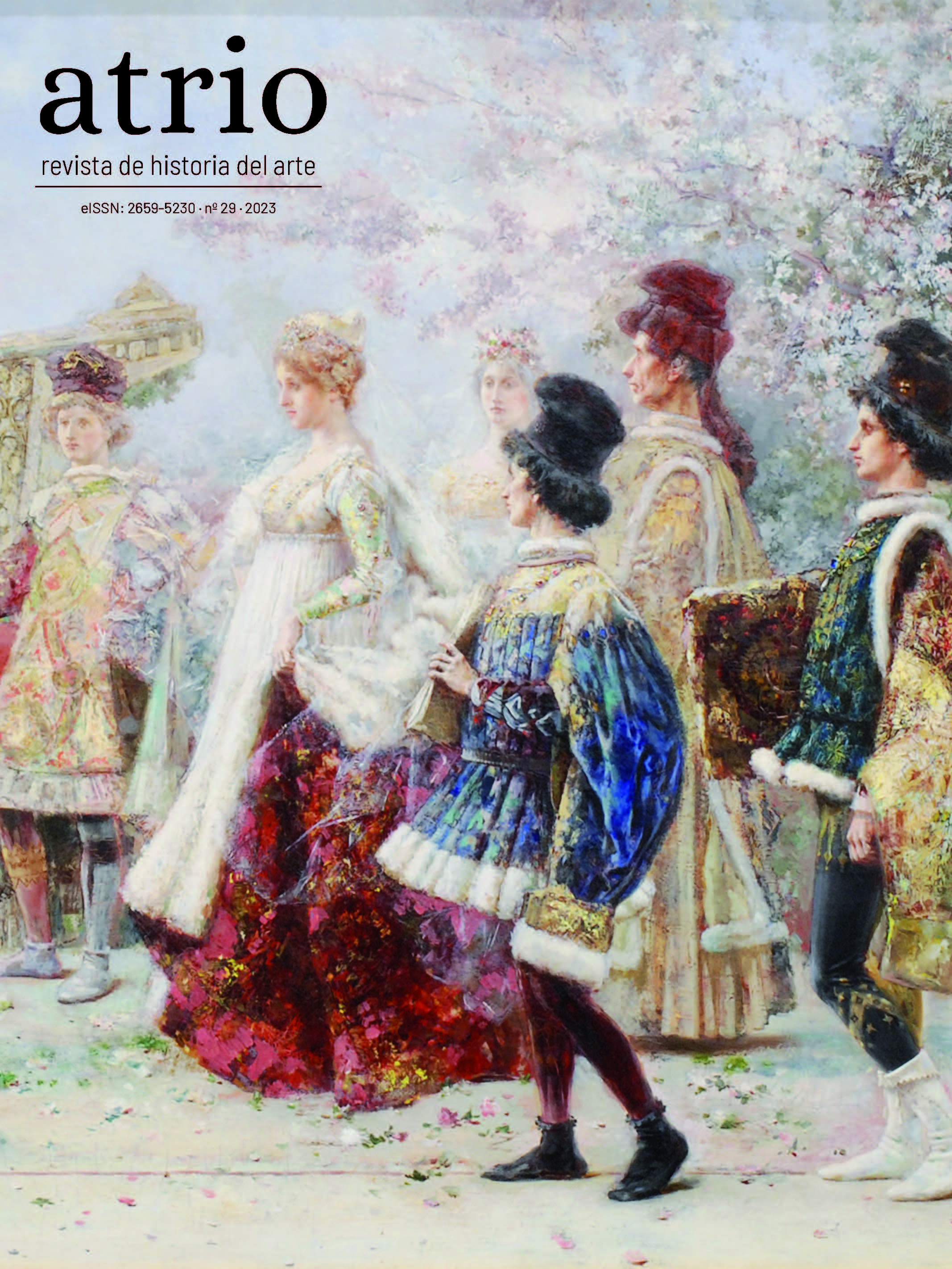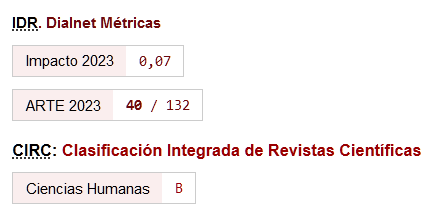La estética del marmor entre la Antigüedad Tardía y la Alta Edad Media. Reflexiones a partir de las fuentes textuales.
DOI:
https://doi.org/10.46661/atrio.7258Palabras clave:
Estética, Antigüedad Tardía, Alta Edad Media, Marmor, Rocas decorativas, Fuentes textualesResumen
Discernir las claves estético-simbólicas del marmor es una cuestión especialmente útil para generar hipótesis históricas. Por un lado, estas permiten conocer los porqués del empleo de rocas decorativas, ayudando a profundizar en el conocimiento del fenómeno en su conjunto. Por otro lado, conociendo las dinámicas estéticas del marmor se pueden plantear hipótesis más generalistas sobre los gustos artísticos en la cronología a estudio. Este trabajo se plantea bajo esta premisa básica de utilizar el material pétreo no constructivo como herramienta para la comprensión del pasado, en el marco de la historia de las ideas estéticas. Para ello, se recurre a las fuentes textuales, presentando una recopilación razonada de textos y una posterior reflexión sobre las características estéticas del marmor y su empleo en la Alta Edad Media europea y mediterránea.
Descargas
Citas
Fuentes documentales:
Casiodoro. The letters of Cassiodorus. Traducido por Thomas Hodking. London: Henry Frowde, 1886.
Marqués de la Fuensanta del Valle. Colección de documentos inéditos para la historia de España. T. CV. Madrid: Imprenta de José Perales y Martínez, 1895.
Coripo, Flavio Cresconio. El Panegírico de Justino II. Traducido por Antonio Ramírez de Verger. Sevilla: Universidad de Sevilla, 1985.
Ermoldo, el Negro. Poème sur Louis le Pieux; et Épitres au Roi Pépin. Traducido por Edmond Faral. París: Libraire Ancienne Honoré Champion, 1932.
Flodoardo de Reims. Historia ecclesiae Remensis. Traducido por M. Lejeune. Reims: P. Regnier, imprimeur de l’Academie, 1854.
Heraclio. De coloribus et artibus Romanorum. I colori e le arti dei Romani e la compilazione pseudo-eracliana. Traducido por Chiara Garzya Romano. Bolonia: Il Mulino, 1996.
La navegación de San Brendán. Editado por Fremiot Hernández González. Madrid: Akal, 2006.
Marciano Capela. Las nupcias de Filología y Mercurio. Editado y traducido por Fernando Navarro Antolín. Madrid: CSIC, 2018.
Prudencio. Himnos a los mártires. Editado por Marcial José Bayo. Madrid: Instituto Antonio de Nebrija, 1946.
Prudencio. Obras. Traducido por Luis Rivero García. Madrid: Gredos, 1997.
Sagrada Biblia. Editado por Eloíno Nácar Fuster y Alberto Colunga. Madrid: B.A.C., 1973.
Fuentes bibliográficas:
Anguita Jaén, José María. “El disco de Quiroga y Venancio Fortunato.” En Aντίδωρον. Homenaje a Juan José Moralejo, editado por María José García Blanco, María Teresa Amado Rodríguez, María José Martín Velasco, Amelia Pereiro Pardo, Manuel Enrique Vázquez Buján, 35-46. Santiago: Universidade de Santiago de Compostela, Servizo de Publicacións e Intercambio Científico, 2011.
Anguita Jaén, José María. “El Disco de Quiroga: planteamientos nuevos a la luz de una constatación.” Larouco, no. 6 (2015): 81-100.
Aranda González, Raúl. “El concepto de marmor y su empleo como decoración mural entre la Tardoantigüedad y la Alta Edad Media (s. V-VIII).” En Pintado en la Pared. El muro como soporte visual en la Edad Media, editado por Santiago Manzarbeitia Valle, Matilde Azcárate Luxán, e Irene González Hernando, 313-350. Madrid: Ediciones Complutense, 2019.
Aranda González, Raúl. “Rocas decorativas (marmora) entre la Antigüedad Tardía y la Alta Edad Media en Hispania: Reflexión teórico-metodológica y estado de la cuestión.” En Paisajes e historias en torno a la piedra. La ocupación y explotación del territorio de la cantería y las estrategias de distribución, consumo y reutilización de los materiales lapídeos desde la Antigüedad, editado por Virginia García-Entero, Sergio Vidal Álvarez, Anna Gutiérrez Garcia-Moreno, y Raúl Aranda González, 349-390. Vol. 1 de Monografías de Prehistoria y Arqueología. Madrid: UNED, 2020). https://doi.org/10.5944/monografias.prehistoria.arqueologia.2020.12
Arce, Javier. Esperando a los árabes: los visigodos en “Hispania”, (507-711). Madrid: Marcial Pons, 2011.
Arias Abellán, Carmen. Itinerarios latinos a Jerusalén y al Oriente cristiano. Sevilla: Universidad de Sevilla, 2000.
Barry, Fabio. “Walking on Water: Cosmic Floors in Antiquity and the Middle Ages.” The Art Bulletin LXXXIX, no. 4 (2007): 627-656. https://doi.org/10.1080/00043079.2007.10786367.
Bermejo Barrera, José Carlos. “Crónicas, reliquias, piedras legendarias y coronaciones en la Edad Media.” Cuadernos de historia del derecho, no. 23 (2016): 11-40. https://doi.org/10.5209/rev_CUHD.2016.v23.53057.
Canto, Alicia María. “Fuentes árabes para la Mérida romana.” Cuadernos Emeritenses, no. 17, (2001): 12-86.
De Bruyne, Edgar. La Estética de la Edad Media. Madrid: Visor, 1987.
Eco, Umberto. Arte y belleza en la estética medieval. Barcelona: Debolsillo, 2012.
Flood, Finbarr Barry. “‘God’s Wonder’: Marble as Medium and the Natural Image in Mosques and Modernism.” A Journal of Decorative Arts, Design History, and Material Culture 23, no. 2 (2016): 168-219. https://doi.org/10.1086/691611.
Fobelli, Maria Luigia. Un tempio per Giustiniano. Santa Sofia di Costantinopoli e la ‘Descrizione’ di Paolo Silenziario. Roma: Viella, 2005.
Gnoli, Raniero. Marmora romana. Roma: Edizioni dell’elefante, 1988.
Godoy Fernández, Cristina. Arqueología y liturgia. Iglesias hispánicas (Siglos IV al VIII). Barcelona: Universitat de Barcelona, 1995.
Gutierrez Garcia-M., Anna. Roman quarries in the northeast of Hispania (modern Catalonia). Tarragona: ICAC, 2009.
Hoyo Calleja, Javier del. “Carmina latina epigraphica del noroeste hispano.” En Actas del XI Congreso Español de Estudios Clásicos, coordinado por Antonio Alvar Ezquerra, 877-886. Madrid, Sociedad Española de Estudios Clásicos, 2003.
Kennell, Stephanie Adelaide Hillert. “Hercules invisible basilica (Cassiodorus “Variae” I, 6).” Latomus, t. 53 (1994): 159-175.
Lamesa, Anaïs, Annie Blanc, y Philippe Blanc. “Les pierres marbrières dans la construction des villes antiques et à Constantinople.” En Construire la ville. Histoire urbaine de la pierre à bâtir, editado por Jean-Pierre Gély, Jacqueline Lorenz, y François Blary, 83-92. Paris: CTHS, 2014.
López Brenes, Manuel Enrique, y Roberto Marín Guzmán. “Los tesoros en la conquista Árabe de Al-Ándalus y las contradicciones en las fuentes árabes.” Revista Estudios, Extra 0, (2019): 371-428. https://doi.org/10.15517/re.v0i0.36275.
Mango, Cyril. The art of the Byzantine Empire 312-1453: sources and documents. Englewood Cliffs: Prentice-Hall, 1972.
Mayer, Marc, e Isabel Rodà. “El comercio del mármol en el mediterráneo y su reflejo en la ciudad romana de Sagunt.” En Saguntum y el mar, coordinado por Carmen Aranegui Gascó, 37-45. Valencia: Generalitat Valenciana, 1991.
McVey, Kathleen. “The Domed Church as microcosm: literary roots of an architectural symbol.” Dumbarton Oaks Papers, no. 37, (1983): 91-121. https://doi.org/10.2307/1291479.
Morán Sánchez, Carlos Jesús. Piedras, ruinas, antigüallas. Visiones de los restos arqueológicos de Mérida (S. XVI-XIX). Mérida: Junta de Extremadura, 2009.
Pérez Álvarez, Mª Ángeles. Fuentes árabes de Extremadura. Cáceres: Universidad de Extremadura, 1992.
Pradier Sebastián, Adrián. “La estética de la luz en la edad media. De ps. Dionisio areopagita a Roberto Grosseteste.” Tesis doctoral, Universidad de Salamanca, 2005.
Schibille, Nadine. Hagia Sophia and the Byzantine Aesthetic Experience. Farnham: Ashgate Publishing Ltd., 2014.
Serrano Martín, Eliseo. “‘Silentium facite’: el fin de la polémica y el discurso en torno a la Virgen del Pilar en la Edad Moderna.” Hispania: Revista española de historia, no. 74, 128 (2014): 687-714. https://doi.org/10.3989/hispania.2014.020.
Tatarkiewicz, Wladyslaw. Historia de la Estética. II La Estética medieval. Madrid: Akal, 1987.
Vasco Rocca, Sandra. Santa Bibiana. Roma: Istituto di Studi Romani, 1983.
Ward-Perkins, John Bryan. “Marmor.” En Enciclopedia dell’arte antica, classica e orientale, coordinado por Ranuccio Bianchi Bandinelli, 860-870. Vol. IV. Roma: Istituto della Enciclopedia Italiana, 1961.
Yarza, Joaquín, Milagros Guardia, y Teresa, eds. Arte medieval. Fuentes y documentos para la historia del arte, 2-3. Barcelona: Gustavo Gili, 1982.
Publicado
Cómo citar
Número
Sección
Licencia
Derechos de autor 2023 Raúl Aranda González

Esta obra está bajo una licencia internacional Creative Commons Atribución-NoComercial-CompartirIgual 4.0.
Los autores/as que publican en Atrio. Revista de historia del arte están de acuerdo con los siguientes términos:
- Los autores/as conservan los derechos de autor y garantizan a la revista el derecho de ser la primera publicación del trabajo al igual que licenciado bajo una licencia de Creative Commons Attribution-NonCommercial-ShareAlike 4.0 International License que permite a otros compartir el trabajo con un reconocimiento de la autoría de este y la publicación inicial en esta revista.
- El autor/a o cedente del material que se entrega para su publicación autoriza a la revista para que publique, sin obligación alguna (económica o de otra naturaleza), el contenido del referido manual tanto en formato papel, como en digital, así como en cualquier otro medio. Esta cesión de uso del material entregado comprende todos los derechos necesarios para la publicación del material en la revista. Quedan garantizados, simultáneamente, los derechos morales del autor
- El autor/a o cedente es plenamente consciente y está de acuerdo con que todos o cualesquiera de los contenidos proporcionados, formarán una obra cuyo uso se cede a la revista para su publicación total o parcial.
- El autor/a o cedente garantiza ser el titular de los derechos de Propiedad Intelectual sobre los contenidos proporcionados, es decir, sobre el propio texto e imágenes/fotografías/obras fotográficas que se incorporan en su artículo.
- El autor/a o cedente asegura y garantiza: (i) que todo el material enviado a la revista cumple con las disposiciones legales aplicables; (ii) que la utilización de cualquier material protegido por derechos de autor y derechos personales en la concepción del material se encuentra regularizada; (iii) que obtuvo las licencias de derechos, permisos y autorizaciones necesarias para la ejecución del material, inclusive los derechos de imagen, si fueran aplicables; y (iv) que el material no viola derechos de terceros, incluyendo, sin limitarse a estos, los derechos de autor y derechos de las personas.
- El autor/a o cedente, exime a la revista de toda y cualquier responsabilidad con relación a la violación de derechos de autor, comprometiéndose a emplear todos sus esfuerzos para auxiliar a la revista en la defensa de cualquier acusación, medidas extrajudiciales y/o judiciales. Asimismo, asume el abono a la revista de cualquier cantidad o indemnización que esta tenga que abonar a terceros por el incumplimiento de estas obligaciones, ya sea por decisión judicial, arbitral y/o administrativa.











